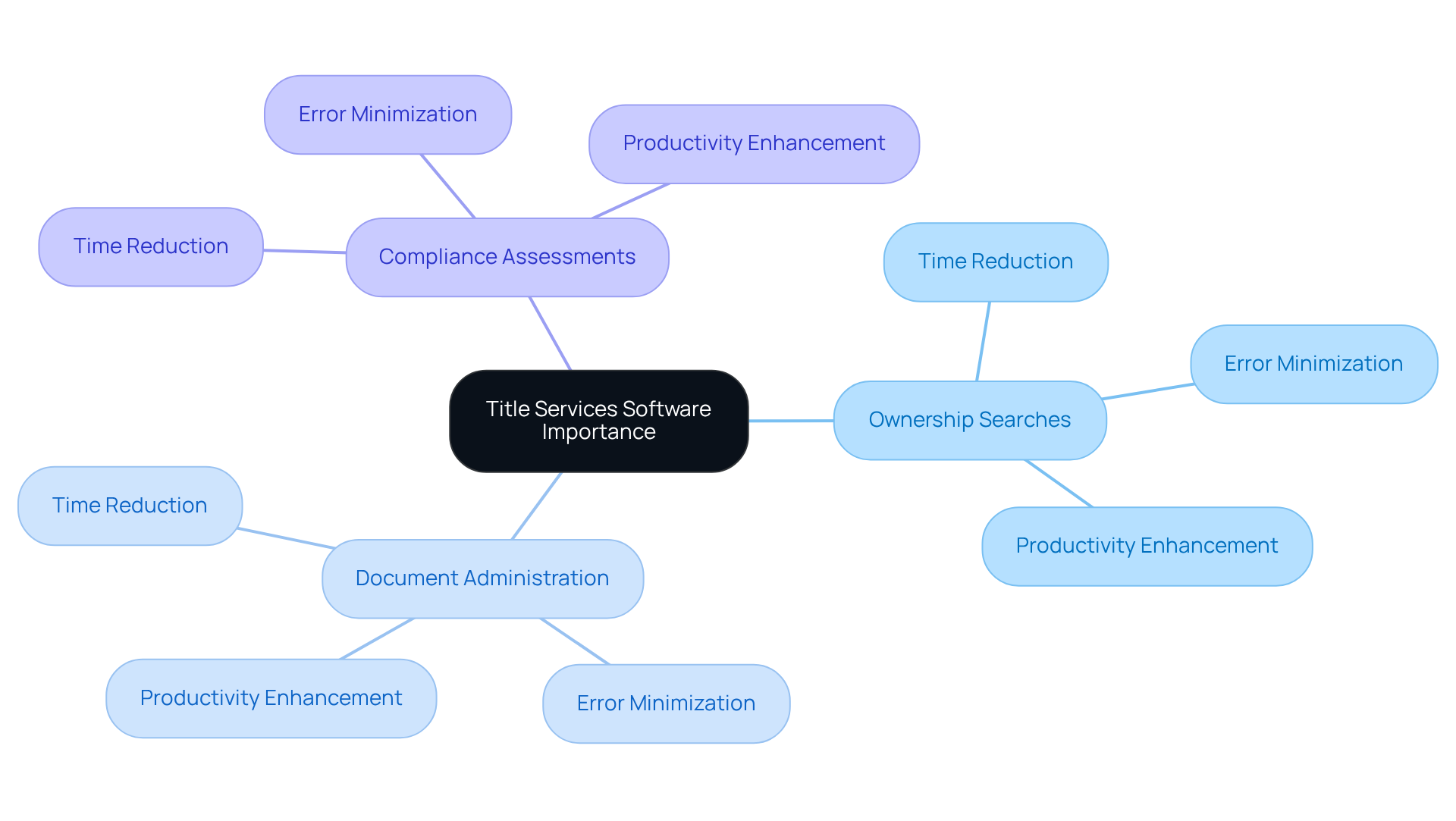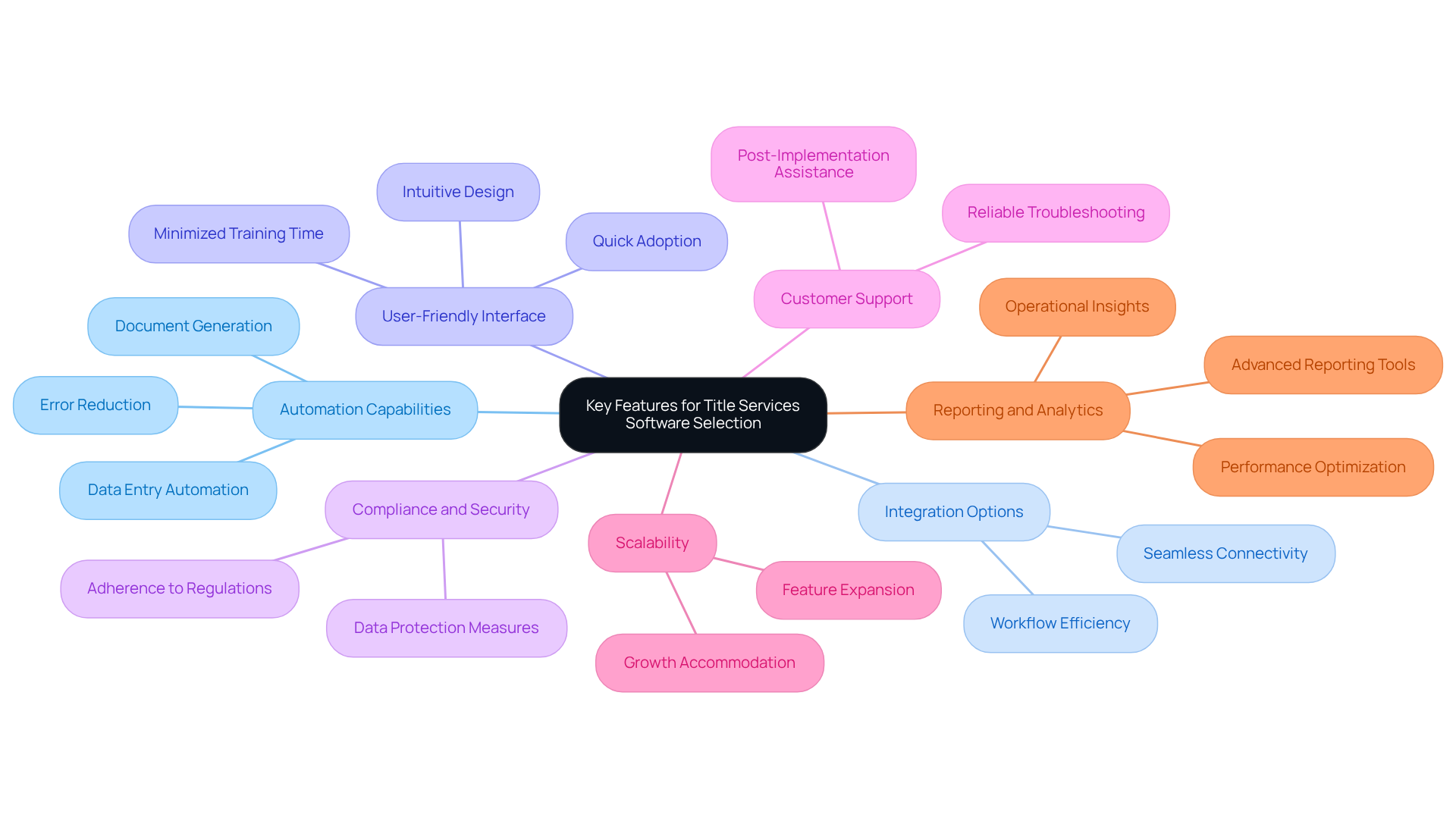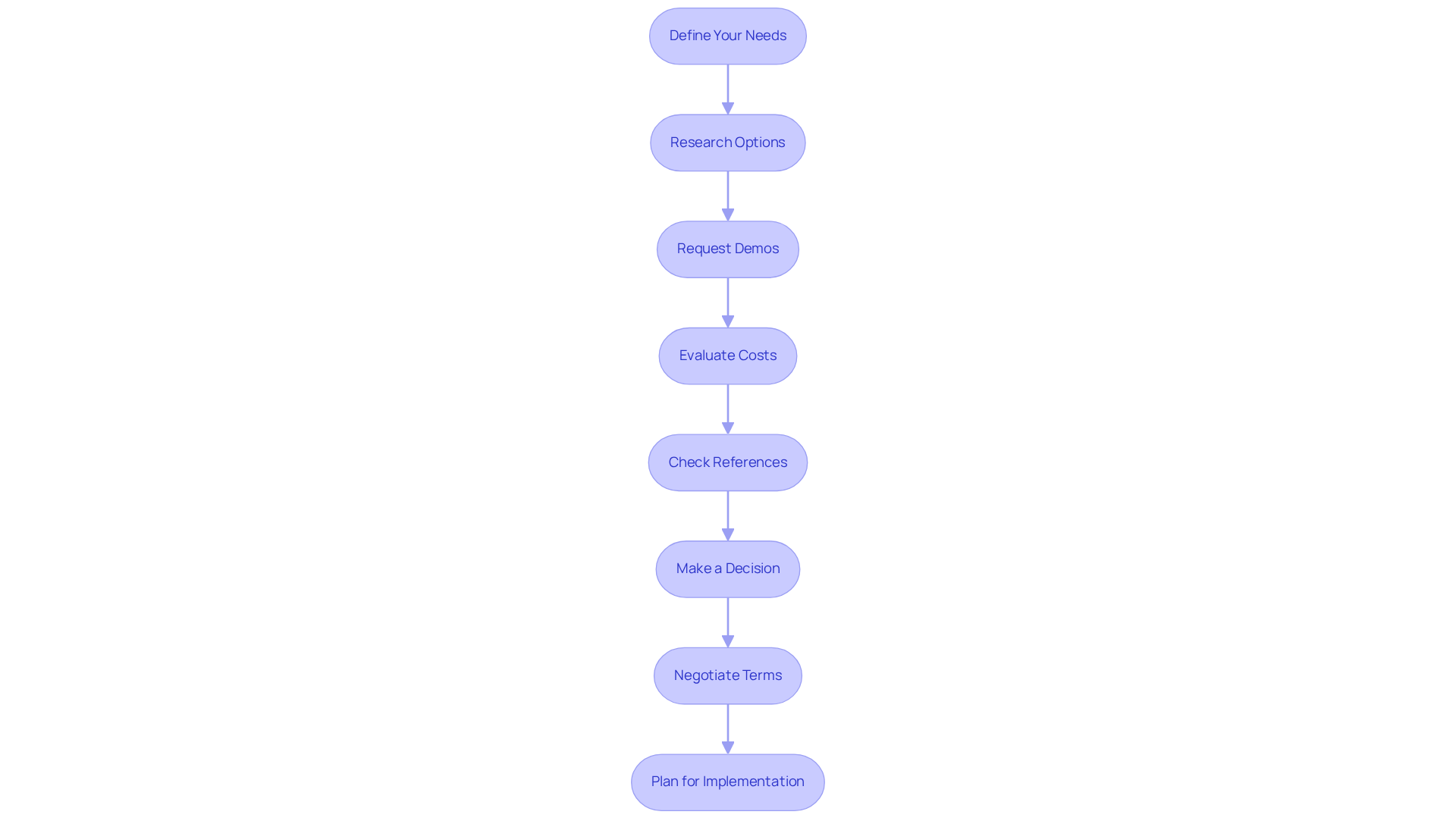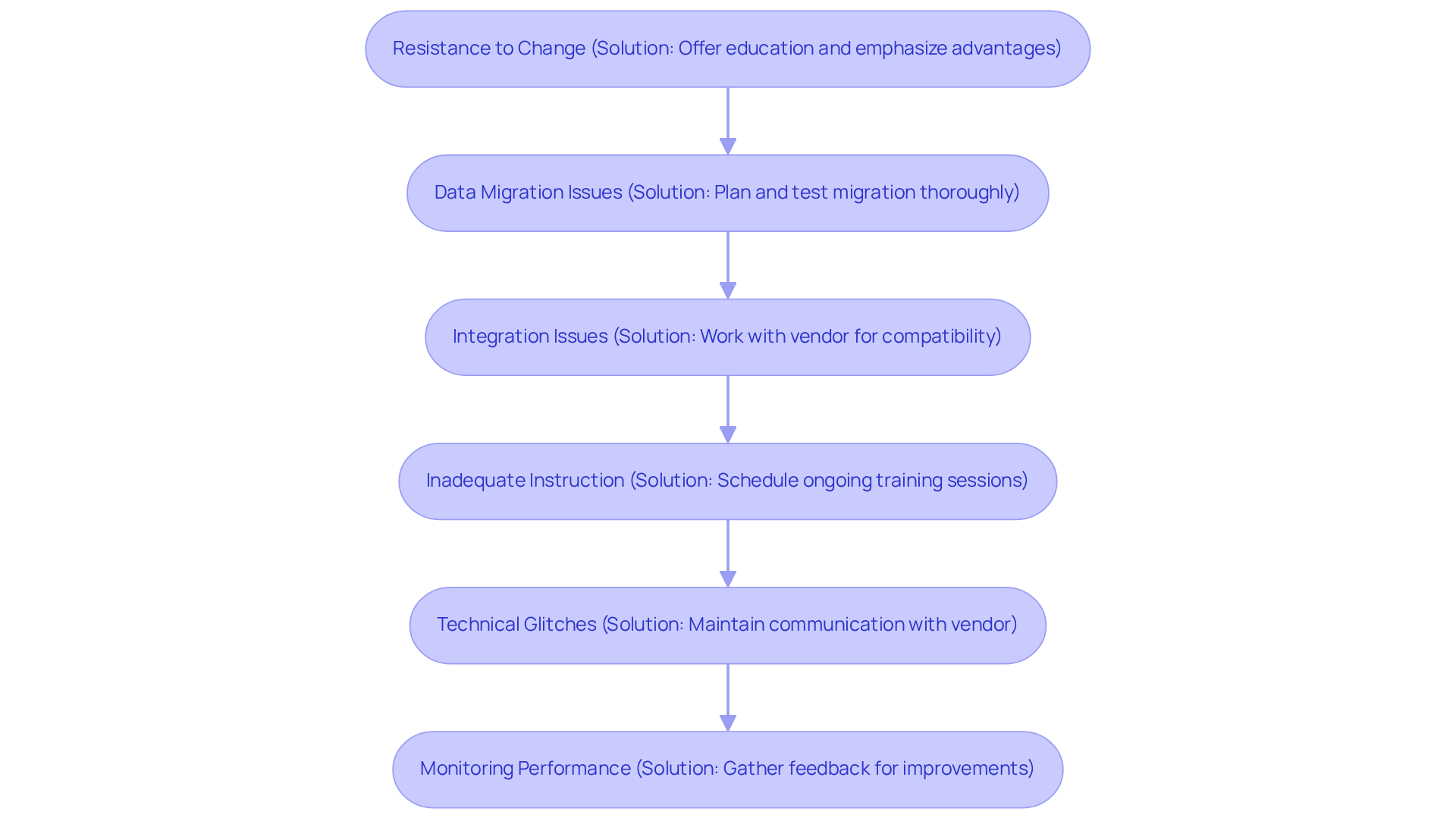Overview
The article delineates a robust four-step process for acquiring land and title services software, underscoring the critical nature of:
- Defining needs
- Researching options
- Requesting demos
- Evaluating costs
Each step is bolstered by comprehensive criteria and considerations, ensuring that the chosen software aligns with operational requirements and budget constraints. This meticulous approach ultimately enhances productivity and compliance within the real estate sector.
Introduction
Navigating the realm of real estate demands a profound comprehension of the tools that optimize operations, with title services software leading this transformation. By automating critical tasks and ensuring compliance, these applications not only boost productivity but also reduce risks linked to property transactions.
However, given the plethora of options available, how can professionals guarantee they choose the right software to meet their distinct needs while steering clear of common implementation pitfalls?
Understand the Importance of Title Services Software
Title-related applications are essential in the real estate sector, automating and optimizing ownership searches, document administration, and compliance assessments. By utilizing these applications, professionals can significantly reduce the time spent on manual tasks, minimize errors, and enhance overall productivity. Furthermore, efficient document management applications ensure that all legal obligations are met, safeguarding against potential conflicts and liabilities. Understanding these advantages is the first step toward making an informed decision regarding which program to buy , as this choice directly impacts the effectiveness and success of your operations.

Identify Key Features and Criteria for Selection
When selecting title services software, it is imperative to consider the following key features:
- Automation Capabilities: A robust solution should automate repetitive tasks, such as document generation and data entry, which not only saves time but also significantly reduces errors.
- Integration Options: It is essential that the application seamlessly connects with existing systems and tools utilized within your organization, thereby facilitating efficient workflows.
- User-Friendly Interface: A is crucial; it promotes quick adoption by staff and minimizes training time.
- Compliance and Security Features: The application must adhere to industry regulations and incorporate strong security measures to safeguard sensitive data effectively.
- Customer Support: Reliable customer support is vital for troubleshooting and ensuring smooth operation after implementation.
- Scalability: Choose applications that can grow alongside your business, accommodating higher transaction volumes and additional features as needed.
- Reporting and Analytics: Advanced reporting tools are essential, providing insights into operations that help identify areas for improvement and optimize overall performance.

Follow a Step-by-Step Process to Purchase Software
To effectively purchase title services software, adhere to the following steps:
- Define Your Needs: Evaluate your existing procedures and pinpoint specific challenges that the application should resolve. When evaluating your options, consider factors such as transaction volume, team size, existing technology, and the decision to buy land and title services software.
- Research Options: Compile a list of potential application solutions that meet your criteria. Utilize online resources, reviews, and recommendations from industry peers to gather comprehensive information on .
- Request Demos: Reach out to vendors to arrange demonstrations of their applications. This enables you to observe the program in action and inquire about its features and capabilities.
- Evaluate Costs: Analyze the pricing structures of the application options, including any hidden fees for implementation, training, or ongoing support. Ensure that the program enables you to buy land and title services software while fitting within your budget constraints.
- Check References: Contact current users of the program to gather feedback on their experiences, particularly regarding customer support and application performance.
- Make a Decision: Based on your research, demos, and feedback, select the software that best meets your needs and budgetary requirements.
- Negotiate Terms: Before concluding the purchase, discuss the conditions of the contract, including pricing, support, and any additional offerings.
- Plan for Implementation: Develop a clear implementation plan that includes timelines, training for staff, and strategies for data migration.

Troubleshoot Common Implementation Challenges
Implementing new title services applications can present various challenges. Understanding these issues is crucial for .
- Resistance to Change: Staff may be reluctant to embrace new applications. To address this, it is essential to offer thorough education and emphasize the advantages of the new system.
- Data Migration Issues: Transferring data from old systems can lead to errors. Therefore, ensure thorough planning and testing of the migration process to minimize data loss or corruption.
- Integration Issues: New applications may not seamlessly work with existing systems. Consequently, work closely with the vendor to address compatibility issues and ensure smooth integration.
- Inadequate Instruction: The absence of guidance can result in underuse of the program. Schedule ongoing training sessions and provide resources for staff to reference as needed.
- Technical Glitches: Software may experience bugs or performance issues. Maintain open communication with the vendor for timely support and updates to resolve technical problems quickly.
- Monitoring Performance: After implementation, continuously monitor the software's performance and gather feedback from users to identify areas for improvement and ensure it meets operational needs.

Conclusion
Understanding the process of purchasing title services software is essential for real estate professionals aiming to enhance operational efficiency and mitigate risks. Recognizing the significance of these applications enables informed decisions that directly influence productivity and compliance in property transactions.
This article outlines a comprehensive approach to selecting the right software, emphasizing the importance of identifying key features, adhering to a structured purchasing process, and addressing common implementation challenges. From defining specific needs and researching options to evaluating costs and negotiating terms, each step is critical for ensuring that the chosen software aligns with organizational goals. Furthermore, troubleshooting potential hurdles during implementation can further streamline the transition to new systems.
Ultimately, investing in the right title services software not only facilitates smoother transactions but also positions businesses for long-term success in a competitive landscape. Embracing these tools can lead to significant improvements in efficiency, accuracy, and overall productivity, making it imperative for real estate professionals to prioritize this aspect of their operations. Taking proactive steps in the selection and implementation process will yield substantial benefits, ensuring that the software serves as a valuable asset in the management of real estate transactions.
Frequently Asked Questions
What is the role of title services software in the real estate sector?
Title services software automates and optimizes ownership searches, document administration, and compliance assessments in the real estate sector.
How does title services software benefit professionals in the industry?
It significantly reduces the time spent on manual tasks, minimizes errors, and enhances overall productivity.
Why is efficient document management important in title services?
Efficient document management ensures that all legal obligations are met, safeguarding against potential conflicts and liabilities.
What should professionals consider when choosing title services software?
Professionals should understand the advantages of the software, as the choice directly impacts the effectiveness and success of their operations.




